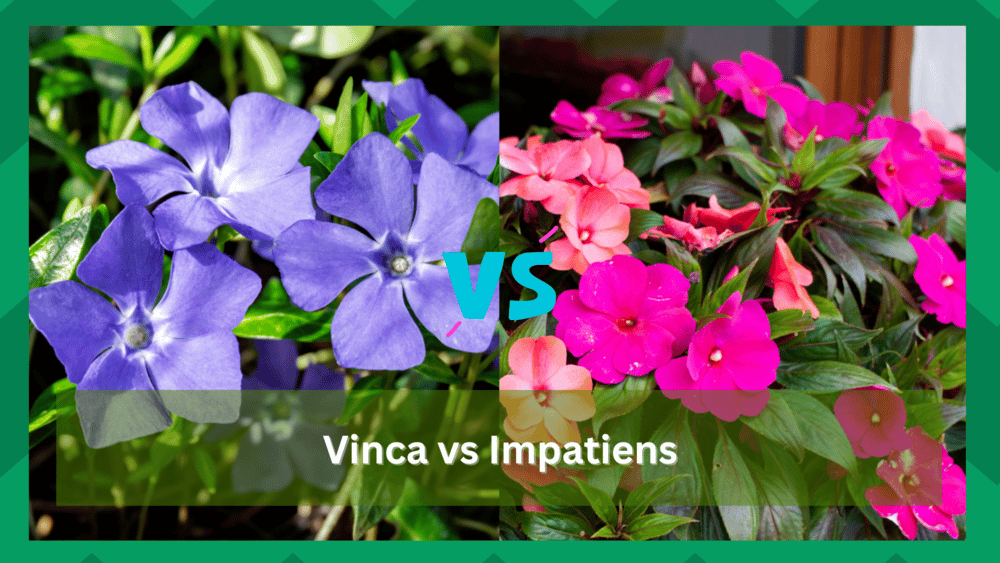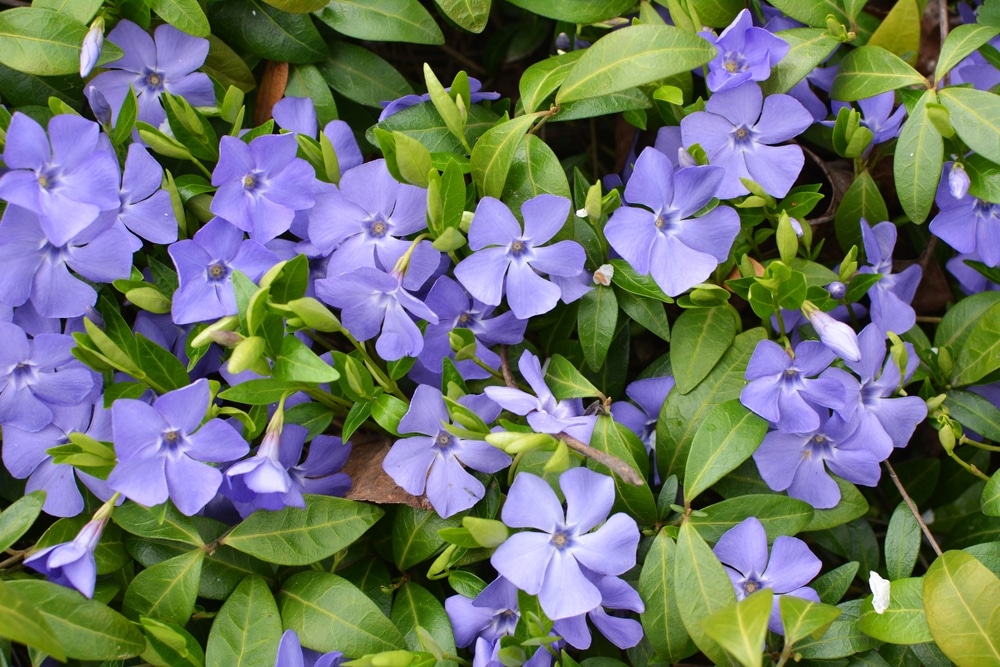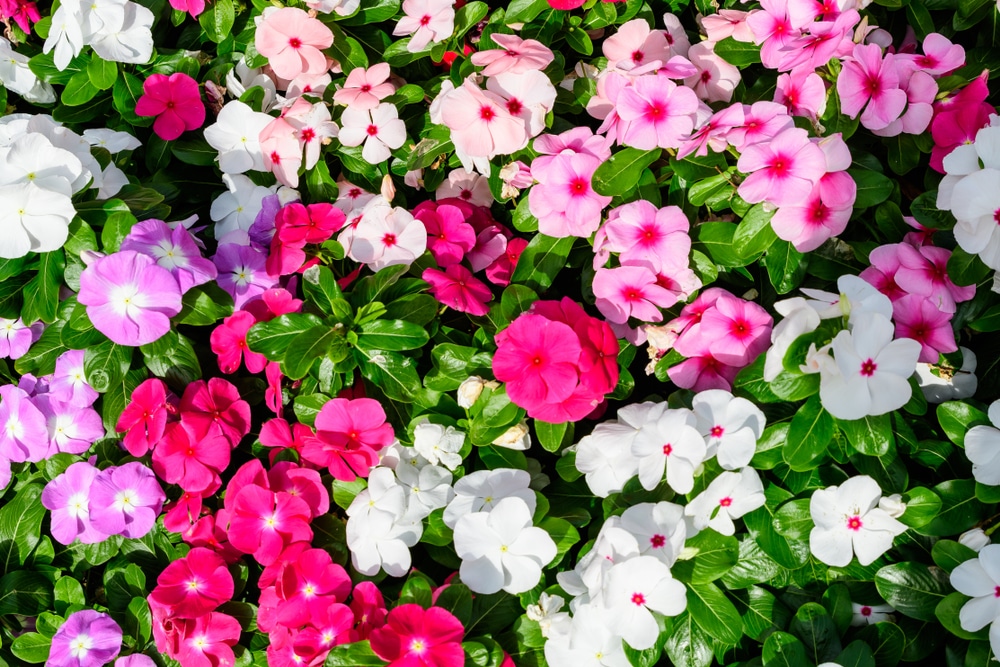
Vinca and Impatiens are two of the most popular flowers that people grow in their gardens. Both of these look amazing and give the house they are planted in an aesthetic look. Another reason why these are so popular is because of how easy it is to grow plants.
Considering this, most beginners or people who can’t take care of flowers decide to plant these. If you compare them side-by-side, then you will think that both of these are different varieties of the same flower.
Because of their similar appearance, round beautiful flowers, and their property of growing low on the ground, people often confuse both of the plants for one.
Additionally, some users can even have trouble trying to differentiate between them. This is why we will be using this article to provide you with a comparison between the two flowers.
Going through it should help you in understanding how these are different from each other, so you know which one you want to plant in your garden.
By knowing these differences you would be able to tell them apart whenever you see them in someone else’s garden and can guide other people too.
Nevertheless, it’s never bad to have some knowledge about beautiful flowers.
The Main Differences Between Vinca vs Impatiens
| Vinca | Impatiens | |
| Family | Apocynaceae | Balsaminaceae |
| Origin | Europe, southwest Asia, and Northwest Africa | Africa and Northern Hemisphere |
| Leaves | Glossy flat | Dark pointed |
| Flowers | White, pink, lilac, rose | Pink, purple, lilac, coral, yellow |
| Stems | 6-18 inches | 2-8 ft |
| Maintenance | Low | High |
Vinca
Vinca is a type of flowering plant that is native to northwest Africa, Europe, and southwest Asia.
While most people refer to this as vinca, you should note that the English name used is periwinkle instead.
The main reason why others avoid using this name is that it is shared with another type of similar flower. This confuses people which is why it is better that you refer to the plant as vinca.
With that being said, you should also note that there are different types of vinca flowers. The most common one is the vinca annual that people plant all around their homes.
This comes in several colors that you can choose from. Depending on your choice, you can either mix the colors or plant a single one.
When it comes to the shape of the vinca, you will notice that the flower is bell-shaped. This is because its structure gets deep from the middle while the petals spread out.
The leaves on this plant have a dark color that shines off when sunlight hits them. Additionally, the tip for these leaves is pointed which helps in differentiating the plant from others even when there are no flowers that have blossomed yet.
Aside from this, you should note that the roots and the way that a plant spreads also help in telling what type it is.
Vinca plants usually spread around the area you have planted them in which is why their roots can be found spreading below the leaf nodes.
Impatiens
Impatiens is a famous type of flower that Is a genus of more than 1000 species of flowering plants.
This means that there are thousands of small flowers that fall under the same category. Considering this, you will notice that people often refer to the flower with different names.
Some of the most common ones used include touch-me-not, patience, snap weed, jewelweed, and impatiens.
These are mostly distributed through the tropics and Northern hemisphere, but the flowers can also be found in other regions. One of the most common things that you will hear about impatiens is how similar they look to vinca.
When it comes to this, you should note that several differences make these flowers unlike and they are a lot.
Starting with the shape of the flower, is completely flat, on the other hand, the bell shape of the vinca makes them look deep. This alone can be enough to tell the flowers apart. However, if you notice a plant that has no flowers on it yet then other methods can be used.
The leaves on impatiens plants have scalloped edges while the color on them is bright green.
The roots and stem of this plant will be upright because it grows tall instead of spreading.
Another thing that you can notice is the condition in which the flower or plant is growing. Vinca is mostly known for surviving both sunlight and shade while impatiens cannot stand heavy sunlight.
The petals on impatiens will start to darken and dry out if put under direct light. This is why you should try planting the flowers under partial or complete shade.
With that being said, going through this article should help you in understanding the differences between the two flowers. You can easily select one of them depending on your preferences.
Vinca vs Impatiens Comparison
Physical Description
The Leaves, Flowers, And Stems Of The Plant
Vinca plants, also called Periwinkles, are perennial plants that you would see blooming the entire year.
The stems of the plants vary depending on the age of the plant and average around 6 to 18 inches in length. The plant can spread because of its ability to make roots whenever stems touch the ground.
The leaves of the Vinca plant are around half to 4 inches wide, dark green in the shade, and have a smooth leathery surface with a pointed tip that helps you differentiate the Vinca plant from the Impatiens plant.
Coming to the flowers of the Vinca plant are 5-leafed and comes in 4 different colors; white, lilac, pink and rose.
The petals of the flowers join together at the base of the flower giving the flowers its exclusive tube shape.
In analogy to the subtle colors of the Vinca flower plant, the Impatiens flowers also come in various colors, including pink, violet, purple, white, and even yellow sometimes.
Some plant varieties even produce double flowers whose petals turn into beautiful miniature rose flower shapes.
They are the best ones to put in your pots, as their growth is very fast and fills the space with beautiful colors wherever they are planted- in the garden or the plant pots.
The size of the plant may vary, ranging between 2 to 8 inches, somewhat smaller than the Vinca plant, but their root-catching capabilities are roughly the same, so wherever the stem touches the ground, it makes root and anchors itself.
Although the flowers of the Impatiens also have 5 petals, the petals usually overlap each other in contrast to the petals of the flowers of the Vinca Plant, which are separated from each other until the flower size is relatively large.
If you are seeing some plants that are unsure if they are Vinca or Impatiens because there are no flowers on them, then don’t worry, as the leaves, colors, and shapes of both these plants are different.
The Vinca plant leaves are bright, glossy, and smooth; impatiens leaves are darker in color and have a more pointed edge giving them a scallop shape.
Growing Vinca And Impatiens
It is important to consider a plant’s growing requirement and maintenance when deciding to grow one in your garden to beautify your area with all the cheerful colors of the plant leaves and flowers.
Considering this, you must know Vinca flowering plant is a low-maintenance plant, so it will go well with you in your garden if you are not too fond of gardening and watering your plants.
On the other hand, Impatiens are plants that require continuous watering and prefer moist soils for better growth and production of flowers.
Vinca plants grow well both in full sun and partial shade. It’s preferable to plant them in the late spring season to have a healthy and better-yielding plant growing in your garden.
In addition to considering the season you are planting these plants in, it is also necessary to watch out that the soil is well draining and sandy.
The Vinca plant requires moderate watering, so it will do well in hot temperatures even if you skip watering them for a day.
Like Vinca plants, the preferable time to plant the impatiens is also late spring, but unlike Vinca plants, humid and hot temperatures don’t suit them well.
So it’s better to grow them where there is enough shade to protect the plants from direct sunlight as the plant can spread, so it’s good to plant them around 4 inches apart.
In addition, the Impatiens are high-maintenance plants, ensure the soil is well-draining, acidic, and moist, and use fertilizer to have a good-yielding plant.
Conclusion
The Vinca and Impatiens are confused with one another due to some of the characteristics they share; originally, both belonged to different families.
The shape of the plant’s leaves and flowers can help you differentiate between the two and help you decide which one you should plant in your garden the next spring.



